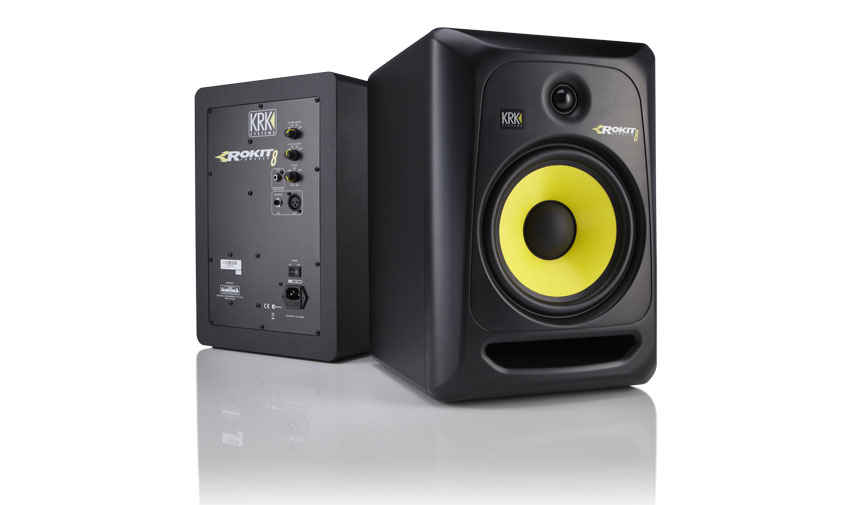MusicRadar Verdict
The largest of this latest generation of Rokit studio monitors packs a powerful punch.
Pros
- +
Plenty of power. Deep and solid low end. High and low frequency adjustment.
Cons
- -
Fairly pricey.
MusicRadar's got your back
KRK's Rokit powered studio monitors are easy to spot from a distance with the distinctive yellow cone on their bass driver making its presence decidedly felt in much the same way as the white cones of Yamaha's NS-10 and subsequent offspring.
Designed and engineered in the USA but made in China, the Rokit 8 (RP8), the largest of the three two-way models (they also have the three-way Rokit 10-3) in KRK's Rokit series, is now in its newly-released third generation, featuring several changes from the previous generation 2 model, notably an upgraded amplifier and tweeter and the inclusion of low frequency adjustment.
As might be expected, the G3 RP8 is physically very similar to the previous model but has had a redesign that makes the front panel a little curvier, losing the ugly screws and seeing the introduction of a different shape for the bass reflex port.
Highs and lows
"The cabinets come fitted with a foam pad on their base to decouple them from whatever surface they are standing on"
As the largest of the three Rokit two-ways it is quite an imposing monitor that may be a touch large for a small bedroom studio but is fine if you have the space and should not offer any problems with placement close to a wall or corner as you can tweak the low end response with the previously mentioned rear panel knob.
This offers three settings apart from flat - you can drop the low end by either 1dB or 2dB or increase it by 1dB if you want a bit extra down there. There's also a high-frequency knob that will let you dial in the very same amount of adjustments at the top end.
No matter what cables you are using, you'll find a way into the RP8s as they offer connection via XLR, 1/4-inch jack and RCA phono. Another thoughtful touch is that the cabinets come fitted with a foam pad on their base to decouple them from whatever surface they are standing on.
Rokit rocks it
When you power up the monitors the KRK logo on the front lights up but if you don't put any sound through them for a while they will enter a 'standby' mode and the light will extinguish until some signal is sent to them.
"Most apparent was the fact that there was a really solid and powerful bass end"
In this bi-amped design, the 1-inch, soft dome tweeter is fed by a 25-watt amp, while the 8-inch woofer gets 75 watts. KRK say that the class A/B amplifier features enhancements over the previous model, offering more headroom with minimal distortion, and that seems to be the case as we were able to turn these up loud to beyond what we'd normally consider the maximum reasonable level for the room without the sound getting out of shape in any way.
First impressions of the Rokits while listening to a reference set of mixes were of a punchy monitor with a smooth top end but most apparent was the fact that there was a really solid and powerful bass end. The bass response is quoted as going down to 35Hz and there is plenty there to let you hear what you are doing when tweaking the bottom end of your mix.
With decent clarity and stereo positioning plus a pleasing overall balance of frequencies, these are capable monitors that could do the job for you once you got familiar with them. Overall then, the Rokit 8 is a shiny new version of a popular monitor that improves upon the legacy of its predecessors.
Trevor Curwen has played guitar for several decades – he's also mimed it on the UK's Top of the Pops. Much of his working life, though, has been spent behind the mixing desk, during which time he has built up a solid collection of the guitars, amps and pedals needed to cover just about any studio session. He writes pedal reviews for Guitarist and has contributed to Total Guitar, MusicRadar and Future Music among others.
With its latest free update, Ableton has finally turned Note into the app I always wanted it to be
Technically capable, but struggle to make your tunes sound musical? 5 simple music theory hacks to make your tracks stand out
"Despite its size, it delivers impressive audio quality and premium functions as well as featuring a good selection of inspired sounds": Roland GO:Piano 88PX review











